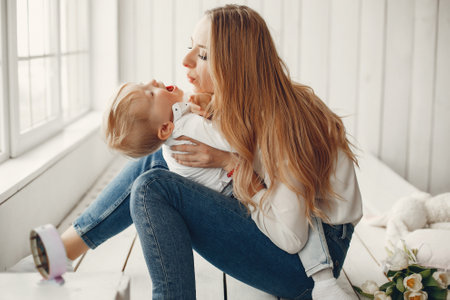Understanding Language Development Milestones
For UK parents, gaining insight into your baby’s speech and language milestones is the first step in nurturing their early communication skills. Babies follow a natural progression as they learn to understand and eventually use words, but knowing what to expect at each stage can help you support their journey with confidence. While every child develops at their own pace, recognising typical milestones can reassure you that your little one is on track—or alert you if additional support might be beneficial. The following table outlines the general timeline for language development commonly observed among babies in the UK:
| Age | Key Language Milestones |
|---|---|
| 0–3 months | Crying, cooing, responding to familiar voices |
| 4–6 months | Babbling, making different sounds, responding to tone of voice |
| 7–12 months | Imitating sounds, turning towards sounds, understanding simple words like “no” or their name |
| 12–18 months | Saying first words (such as “mummy”, “daddy”, “milk”), understanding more words than they can say |
| 18–24 months | Combining two words (e.g., “more juice”), vocabulary expands rapidly |
The above stages are broad guidelines based on research and NHS recommendations specific to families in the UK. It’s important to remember that cultural factors—such as family routines, exposure to multiple languages, and local dialects—can influence when and how babies reach these milestones. By observing your child within this context and recognising their unique pace, you can provide reassurance, encouragement, and timely support as they embark on their language journey.
2. Creating a Language-Rich Environment at Home
Fostering your baby’s first words begins with creating a home environment brimming with language and communication. In the UK, we are fortunate to have a rich tradition of storytelling, nursery rhymes, and songs that can be seamlessly woven into daily routines. Below are practical tips for infusing everyday life with opportunities for language development.
Tips for Daily Language Exposure
- Talk About Everything: Narrate your actions throughout the day—whether you’re making a cup of tea or putting on wellies before heading out. This helps your baby connect words with actions and objects commonly found in UK homes.
- Sing British Nursery Rhymes: Classics like “Twinkle, Twinkle, Little Star,” “Baa Baa Black Sheep,” and “Wind the Bobbin Up” are not just fun—they introduce rhythm, rhyme, and new vocabulary.
- Read Together: Make reading part of your daily routine. Choose books featuring familiar British settings and themes, such as tales by Julia Donaldson or the timeless works of Beatrix Potter.
- Use Everyday Objects: Talk about items around the house (the kettle, pram, or biscuit tin), reinforcing names and uses through repetition.
- Encourage Two-Way Communication: Pause during conversations to allow your baby to respond with coos or babbles, showing that their attempts at communication are valued.
Incorporating Songs and Rhymes
Singing is an enjoyable way to bond and support early speech. Here’s a table of popular UK nursery rhymes to try:
| Nursery Rhyme | Main Language Benefit | When to Sing |
|---|---|---|
| The Grand Old Duke of York | Rhythm & Movement Words | During playtime or walks |
| Humpty Dumpty | Storytelling & Sequence | Nappy changes or bath time |
| Row, Row, Row Your Boat | Turn-taking & Actions | Sitting together on the floor |
| This Little Piggy | Counting & Body Parts | Dressing or changing socks |
| Five Little Ducks | Numbers & Repetition | Before bed or quiet moments |
Selecting Books with Local Flavour
Introduce stories set in familiar places—cottages, countryside, parks—or feature British wildlife like hedgehogs and foxes. Look for interactive board books from local libraries; many offer baby-friendly storytelling sessions where parents can pick up new ideas and meet others on the same journey.
Making Conversation Natural and Fun
Your baby learns best when interactions feel warm and playful. Use gentle encouragement, expressive facial gestures, and plenty of smiles. Remember: every chat over a cuppa or a sing-song in the car counts towards building your child’s first words—and lifelong confidence with language.

3. The Power of Everyday Interactions
Everyday moments are packed with opportunities to nurture your baby’s language development. In the UK, life’s simple routines—like popping to the shops, enjoying a stroll in the local park, or sitting down for tea—offer natural settings for meaningful conversation and playful learning. These familiar activities help babies feel secure while exposing them to new words and experiences.
Turning Daily Routines into Learning Moments
Babies thrive on repetition and predictability. Using everyday tasks as chances to model speech not only builds vocabulary but also strengthens your bond. When you narrate what you’re doing, describe objects, or respond to your baby’s babble, you show them that communication is valuable and fun.
Simple Ways to Model Speech During Common Activities
| Routine | Speech Opportunities |
|---|---|
| Trip to the Park | Name things you see (“Look, a dog!”), talk about actions (“We’re swinging high!”), and echo your baby’s attempts (“Yes, that’s a ‘tree’!”). |
| Grocery Shop | Label foods (“Banana, apple”), count items (“One, two apples”), and include your baby by asking questions (“Which milk shall we get?”). |
| Mealtimes | Describe tastes and textures (“Crunchy carrot”), encourage choices (“Would you like more peas?”), and celebrate their words (“You said ‘more’!”). |
Making the Most of Everyday Talk
- Use short sentences and clear pronunciation.
- Repeat key words and phrases often.
- Praise all attempts at speech—even babbling counts!
- Let your baby lead sometimes; pause and wait for their response.
- Share smiles and eye contact to keep interactions warm and engaging.
These small daily efforts create a rich language environment where your baby feels encouraged to experiment with sounds and words. Remember: it’s not about being perfect, but about being present. The more you talk with your little one during everyday routines, the more confident they’ll become as young communicators.
4. Responsive Parenting: Listening and Encouragement
One of the most powerful ways to support your babys first words is through responsive parenting—a style that centres on being tuned in to your childs needs, emotions, and attempts at communication. In the UK, where open dialogue and gentle guidance are valued in early years education, practising responsive listening and encouragement can nurture both language and emotional development.
Tuned-in Listening: Giving Your Baby Your Full Attention
When your baby babbles or tries to say a word, pause what youre doing and focus on them. Eye contact, smiling, and nodding signal to your little one that you value their efforts. This mindful attention lays the groundwork for secure attachment and motivates your child to keep trying new sounds.
Practical Ways to Practise Tuned-in Listening
| Situation | How to Respond |
|---|---|
| Baby points at a dog and says “da” | Smile warmly, look at the dog together, and say “Yes, thats a dog!” |
| Your child babbles during nappy change | Mimic their sounds, make eye contact, and respond with simple words (“Nappy time! Clean nappy!”) |
| First attempt at saying “milk” | Offer praise: “You said milk! Well done! Would you like some milk?” |
Turn-Taking: Building Early Conversation Skills
Conversations are a two-way street—even before your child can speak fluently. In British homes, turn-taking is encouraged from an early age as it fosters respect and cooperation. When your baby makes a sound or gesture, wait patiently before responding. Then reply with enthusiasm, using simple sentences or repeating their attempt back with correct pronunciation.
The Turn-Taking Technique
- Wait: Pause after your child speaks or gestures.
- Respond: Echo their sound or add a new word (“Ball? Yes, thats your ball!”).
- Encourage: Invite another turn by asking a question or making an excited face.
Gentle Encouragement: Balancing Correction with Positivity
Your babys first words may not be perfect—and thats absolutely fine. Instead of correcting mistakes directly, model the right word gently within your response. For example, if your child says “buh” for “book,” you might reply, “Yes, thats your book! Shall we read the book together?” This approach builds confidence while subtly guiding correct pronunciation.
Positivity Over Perfection: Everyday Phrases to Use
| If Your Child Says… | You Can Respond With… |
|---|---|
| “Ba” (for ball) | “Thats right! Its your ball.” |
| “Wawa” (for water) | “Would you like some water? Here’s your water.” |
| “Ca” (for car) | “Look at the car! The car goes vroom.” |
This balance of positivity and gentle correction helps children feel safe to experiment with language while gradually learning new words. Remember: every attempt is a step forward in building both vocabulary and emotional connection between you and your child.
5. Beyond Words: Gestures and Non-Verbal Communication
While your baby’s first words are an exciting milestone, it’s important to remember that communication goes far beyond spoken language. In the UK, we often value polite gestures such as waving “hello” or “goodbye,” nodding to show agreement, or using facial expressions to convey feelings. Babies naturally learn these social cues through everyday interactions, and these non-verbal forms of communication play a crucial role in their language and social development.
The Power of Gestures in Early Communication
Before your little one can string together sentences, they often rely on gestures like pointing to request a favourite toy or reaching out for a cuddle. These actions show they are making connections between objects, people, and words—an essential part of early language learning. In fact, British research highlights that children who use gestures like pointing often develop stronger vocabulary later on.
Common Gestures and Their Meanings
| Gesture | Meaning | How Parents Can Respond |
|---|---|---|
| Pointing | Requesting or sharing interest | Name the object: “Yes, that’s your teddy!” |
| Waving | Greeting or saying goodbye | Model the gesture: “Wave bye-bye to Granny!” |
| Facial Expressions | Expressing feelings (happy, sad, surprised) | Mirror their expression and label the emotion: “You look excited!” |
| Nodding/Shaking Head | Saying yes or no without words | Acknowledge and encourage: “You don’t want more peas? That’s okay.” |
Cultural Nuances in UK Communication Styles
British culture places value on subtlety and politeness in communication. Teaching your child to use gentle gestures and respectful expressions helps them fit into nursery or playgroup settings. For example, encouraging your baby to wave when leaving a playdate fosters positive social connections from an early age.
Tips for Supporting Non-Verbal Development at Home
- Model everyday gestures: Use natural opportunities throughout the day, such as waving during school run drop-offs or nodding during storytime.
- Describe feelings: Help your child link emotions to expressions by narrating what you see: “I can see you’re smiling—you must be happy!”
- Praise attempts: Celebrate all efforts at non-verbal communication as warmly as you do first words.
- Create routines: Consistent gestures like blowing kisses at bedtime help reinforce emotional bonds.
Nurturing your baby’s gestures and non-verbal skills alongside their first words creates a well-rounded communicator ready for all the rich social experiences British life has to offer.
6. When to Seek Support: Spotting Signs of Speech Delay
Every child develops at their own pace, but as a UK parent, it’s important to recognise when your baby might need extra support with their speech. Early intervention can make a significant difference, and the NHS provides invaluable services through health visitors and speech and language therapists. Here’s how to spot concerns and where to turn for help in the UK context.
Clear Indicators Your Baby May Need Extra Support
| Age | Typical Milestones | Signs to Seek Advice |
|---|---|---|
| 12 months | Babbles, tries simple words like “mama”, responds to name | No babbling or gestures (pointing, waving), not responding to sounds |
| 18 months | Says 5-20 words, imitates speech, understands simple instructions | No single words, doesn’t imitate sounds or actions, little interest in communication |
| 24 months | Combines two words (“more milk”), follows basic instructions, recognises familiar objects by name | No word combinations, unclear speech most of the time, limited vocabulary (less than 50 words) |
Navigating the NHS System for Speech Concerns
- Contact Your Health Visitor: In the UK, health visitors are your first point of contact for child development worries. They offer regular check-ups and can assess your baby’s communication skills during routine visits.
- Referral to a Speech and Language Therapist: If concerns persist, your health visitor can refer you directly to an NHS speech and language therapist (SALT). Therapists will carry out a detailed assessment and provide tailored advice or intervention if needed.
- Culturally Relevant Support: The NHS and local councils often provide multilingual resources and interpreters for families from diverse backgrounds. You can request translated materials or ask for cultural support during appointments.
- Community Resources: Children’s Centres across the UK run “stay and play” sessions that support early language development in a culturally inclusive environment. Many also host drop-in clinics with speech specialists.
- Online Information: Trusted sites such as NHS Speech and Language Therapy, Talking Point, and I CAN Charity offer guidance tailored for UK families.
When Should You Act?
If you notice any of the signs listed above—or simply have a gut feeling that something isn’t right—it’s always better to seek advice early. Trust your instincts; you know your child best. Prompt support not only helps your baby’s language journey but also reassures you as a parent navigating this important developmental milestone within the UK system.


